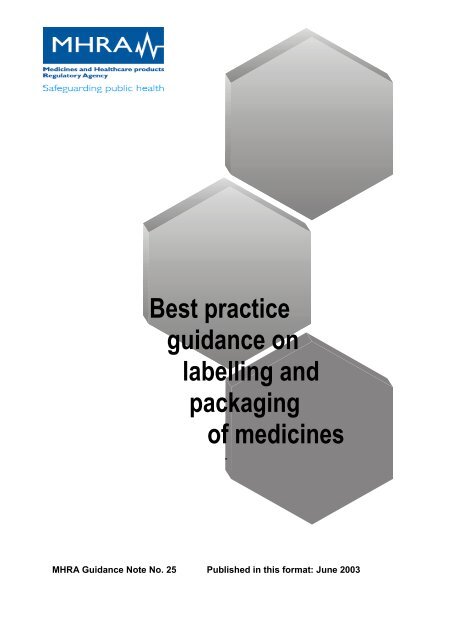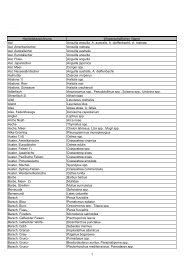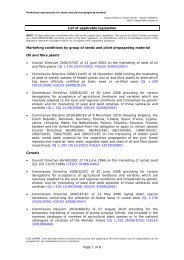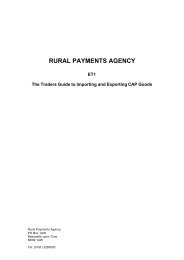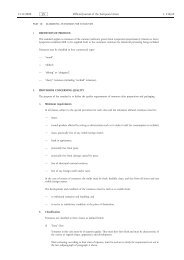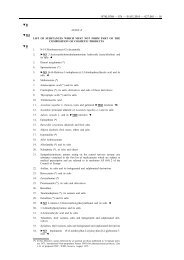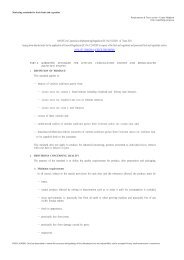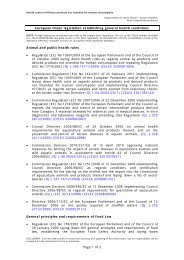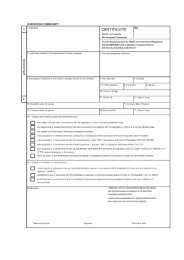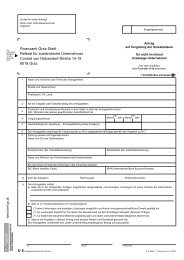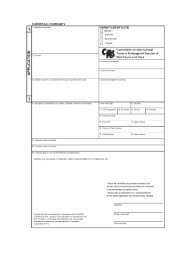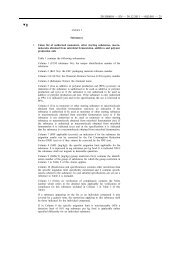best practice guidance on the labelling and packaging of medicines
best practice guidance on the labelling and packaging of medicines
best practice guidance on the labelling and packaging of medicines
You also want an ePaper? Increase the reach of your titles
YUMPU automatically turns print PDFs into web optimized ePapers that Google loves.
Best <str<strong>on</strong>g>practice</str<strong>on</strong>g><str<strong>on</strong>g>guidance</str<strong>on</strong>g> <strong>on</strong><strong>labelling</strong> <strong>and</strong><strong>packaging</strong><strong>of</strong> <strong>medicines</strong>MHRA Guidance Note No. 25 Published in this format: June 2003
Date <strong>of</strong> preparati<strong>on</strong>: December 2002. Published in this format: June 2003.Medicines <strong>and</strong> Healthcare products Regulatory AgencyMarket Towers1 Nine Elms LaneVauxhallL<strong>on</strong>d<strong>on</strong> SW8 5NQPublished by <strong>the</strong> Medicines <strong>and</strong> Healthcare products Regulatory Agency 2003This MHRA Guidance Note should not be taken as a complete or definitive statement <strong>of</strong> <strong>the</strong>law. It is not intended as a substitute for legal or o<strong>the</strong>r pr<strong>of</strong>essi<strong>on</strong>al advice. The MHRA acceptsno liability for any loss or damage caused, arising directly, or indirectly, in c<strong>on</strong>necti<strong>on</strong> withreliance <strong>on</strong> <strong>the</strong> c<strong>on</strong>tents <strong>of</strong> this <str<strong>on</strong>g>guidance</str<strong>on</strong>g> note.
BEST PRACTICE GUIDANCE ON THE LABELLING AND PACKAGING OFMEDICINES1. INTRODUCTIONThe safe use <strong>of</strong> all <strong>medicines</strong> depends <strong>on</strong> users reading <strong>the</strong> <strong>labelling</strong> <strong>and</strong> <strong>packaging</strong>carefully <strong>and</strong> accurately <strong>and</strong> being able to assimilate <strong>and</strong> act <strong>on</strong> <strong>the</strong> informati<strong>on</strong>presented. The primary purpose <strong>of</strong> <strong>medicines</strong> <strong>labelling</strong> <strong>and</strong> <strong>packaging</strong> should be <strong>the</strong>clear unambiguous identificati<strong>on</strong> <strong>of</strong> <strong>the</strong> medicine <strong>and</strong> <strong>the</strong> c<strong>on</strong>diti<strong>on</strong>s for its safe use.Comm<strong>on</strong> factors affecting all users <strong>of</strong> <strong>medicines</strong> may be summarised under threeheadings: INFORMATION: Certain items <strong>of</strong> informati<strong>on</strong> are vital for <strong>the</strong> safe use <strong>of</strong> <strong>the</strong>medicine. FORMAT: The informati<strong>on</strong> must be presented in a legible manner that iseasily understood by all those involved in <strong>the</strong> supply <strong>and</strong> use <strong>of</strong><strong>the</strong> medicine. STYLE: There is potential for c<strong>on</strong>fusi<strong>on</strong> between both similarity in drugnames <strong>and</strong> similarity in <strong>medicines</strong> <strong>packaging</strong>.Medicati<strong>on</strong> errors occur due to many factors. “Building a Safer NHS for Patients”(1)published in April 2001, which implemented “Organisati<strong>on</strong> With A Memory”(2),identified such factors as training, communicati<strong>on</strong>, storage, <strong>and</strong> supervisi<strong>on</strong>.Problems with <strong>labelling</strong> have also been associated with a high percentage <strong>of</strong> errors(3). Within <strong>the</strong> current regulatory framework <strong>the</strong>re is <strong>the</strong> potential for improving <strong>the</strong>layout <strong>of</strong> <strong>medicines</strong> <strong>labelling</strong> to aid clarity. This would assist health pr<strong>of</strong>essi<strong>on</strong>als <strong>and</strong>patients/carers to select <strong>the</strong> correct medicine <strong>and</strong> use it safely, <strong>the</strong>reby helping tominimise medicati<strong>on</strong> errors.2. PURPOSEThe purpose <strong>of</strong> this <str<strong>on</strong>g>guidance</str<strong>on</strong>g> is to exp<strong>and</strong> a set <strong>of</strong> principles which have been agreedby <strong>the</strong> Committee <strong>on</strong> Safety <strong>of</strong> Medicines. When <strong>the</strong> <str<strong>on</strong>g>guidance</str<strong>on</strong>g> is applied it will helpto ensure that <strong>the</strong> critical informati<strong>on</strong> necessary for <strong>the</strong> safe use <strong>of</strong> <strong>the</strong> medicine islegible, easily accessible <strong>and</strong> that users <strong>of</strong> <strong>medicines</strong> are assisted in assimilating thisinformati<strong>on</strong> so that c<strong>on</strong>fusi<strong>on</strong> <strong>and</strong> error are minimised. In preparing this <str<strong>on</strong>g>guidance</str<strong>on</strong>g>, itis acknowledged that different users <strong>of</strong> <strong>medicines</strong> require <strong>and</strong> use informati<strong>on</strong>differently. Those involved in <strong>the</strong> design <strong>of</strong> <strong>labelling</strong> <strong>and</strong> <strong>packaging</strong> comp<strong>on</strong>entsshould ensure that <strong>the</strong> following secti<strong>on</strong>s are taken into account prior to submissi<strong>on</strong> to<strong>the</strong> Medicines <strong>and</strong> Healthcare products Regulatory Agency as any deviati<strong>on</strong>s fromthis <str<strong>on</strong>g>guidance</str<strong>on</strong>g> may need to be justified.3. SCOPEThis is <str<strong>on</strong>g>best</str<strong>on</strong>g> <str<strong>on</strong>g>practice</str<strong>on</strong>g> <str<strong>on</strong>g>guidance</str<strong>on</strong>g> to be read al<strong>on</strong>gside <strong>the</strong> legislative requirements, whichare set out in Title V <strong>of</strong> Council Directive 2001/83/EEC (4). The <str<strong>on</strong>g>guidance</str<strong>on</strong>g> has nolegal st<strong>and</strong>ing but it will be taken into account when <strong>the</strong> Medicines <strong>and</strong> Healthcareproducts Regulatory Agency assesses <strong>the</strong> <strong>labelling</strong> provided with mutual recogniti<strong>on</strong><strong>and</strong> nati<strong>on</strong>al licence applicati<strong>on</strong>s. The <str<strong>on</strong>g>guidance</str<strong>on</strong>g> applies primarily to prescripti<strong>on</strong> <strong>on</strong>ly
<strong>medicines</strong> but <strong>the</strong> principles should be applied as appropriate to all <strong>medicines</strong>,including those available over <strong>the</strong> counter.In assessing applicati<strong>on</strong>s, <strong>the</strong> Agency will c<strong>on</strong>sider patient safety, in <strong>the</strong> light <strong>of</strong>experience <strong>and</strong> any adverse incidents reported.4. GENERAL CONSIDERATIONSThe following items will apply to all <strong>labelling</strong> comp<strong>on</strong>ents, where relevant, whe<strong>the</strong>ror not a lesser informati<strong>on</strong> set is applicable by virtue <strong>of</strong> Article 55 <strong>of</strong> CouncilDirective 2001/83/EEC.4.1. Labelling must c<strong>on</strong>tain all elements required by article 54 <strong>of</strong> CouncilDirective 2001/83/EEC. Never<strong>the</strong>less, certain items <strong>of</strong> informati<strong>on</strong> aredeemed critical for <strong>the</strong> safe use <strong>of</strong> <strong>the</strong> medicine These items are name <strong>of</strong> <strong>the</strong> medicine expressi<strong>on</strong> <strong>of</strong> strength (where relevant) route <strong>of</strong> administrati<strong>on</strong> posology warningsClarificati<strong>on</strong> <strong>on</strong> <strong>the</strong>se items is provided below.4.2. These critical items <strong>of</strong> informati<strong>on</strong> should be located toge<strong>the</strong>r <strong>on</strong> <strong>the</strong> pack<strong>and</strong> appear in <strong>the</strong> same field <strong>of</strong> view where practicable. These items shouldnot be broken up by additi<strong>on</strong>al informati<strong>on</strong>, logos or background texts orgraphics.4.2.1 Name <strong>of</strong> <strong>the</strong> medicine.The name that is registered in <strong>the</strong> summary <strong>of</strong> product characteristics (SPC)must be used <strong>on</strong> all <strong>packaging</strong> comp<strong>on</strong>ents. The name is defined ascomprising <strong>the</strong> name, strength <strong>and</strong> pharmaceutical form <strong>of</strong> <strong>the</strong> medicine. For<strong>medicines</strong> that include ei<strong>the</strong>r a company name or a trademark as part <strong>of</strong> <strong>the</strong>product name, this must be reflected <strong>on</strong> all <strong>packaging</strong> comp<strong>on</strong>ents where <strong>the</strong>name is required to appear. The name registered in <strong>the</strong> SPC may not beabbreviated for inclusi<strong>on</strong> <strong>on</strong> <strong>the</strong> <strong>labelling</strong> <strong>and</strong> should be selected with this inmind.The full name <strong>of</strong> <strong>the</strong> medicine should appear <strong>on</strong> at least three n<strong>on</strong>opposingfaces <strong>of</strong> <strong>the</strong> pack to aid accurate identificati<strong>on</strong> <strong>of</strong> <strong>the</strong> drug. Thisis applicable <strong>on</strong>ly to cart<strong>on</strong> presentati<strong>on</strong>s in which case <strong>the</strong> end-face <strong>of</strong> <strong>the</strong>pack should include <strong>the</strong> full name <strong>of</strong> <strong>the</strong> product. However, an abbreviatedpharmaceutical form may be used <strong>on</strong> <strong>the</strong> label in <strong>the</strong> interests <strong>of</strong> clarity for <strong>the</strong>patient but must accord with abbreviati<strong>on</strong>s accepted by <strong>the</strong> member states <strong>and</strong><strong>the</strong> Commissi<strong>on</strong>. [The full pharmaceutical form, employing st<strong>and</strong>ard terms,must appear in secti<strong>on</strong> 3 <strong>of</strong> <strong>the</strong> SPC.]Where <strong>the</strong> medicine c<strong>on</strong>tains a single active ingredient, <strong>the</strong> comm<strong>on</strong> name <strong>of</strong>this active ingredient should immediately follow <strong>the</strong> name <strong>of</strong> <strong>the</strong> medicine <strong>on</strong><strong>the</strong> pack, unless it is part <strong>of</strong> <strong>the</strong> name. There should be no intervening text <strong>of</strong>any kind. The recommended Internati<strong>on</strong>al N<strong>on</strong>-proprietary Name should be
used, or <strong>the</strong> usual comm<strong>on</strong> name where no rINN exists. Where <strong>the</strong> comm<strong>on</strong>name appears after <strong>the</strong> br<strong>and</strong> name, it should be given due prominence.Generally this will be determined by <strong>the</strong> relative size <strong>of</strong> <strong>the</strong> text but o<strong>the</strong>rfactors may be relevant such as colour <strong>of</strong> text <strong>and</strong> <strong>the</strong> f<strong>on</strong>t used.If a medicine c<strong>on</strong>tains more than <strong>on</strong>e active ingredient c<strong>on</strong>siderati<strong>on</strong> should begiven to including all comm<strong>on</strong> names <strong>on</strong> <strong>the</strong> fr<strong>on</strong>t <strong>of</strong> <strong>the</strong> pack wherepracticable.If a “Co-” name is used for <strong>the</strong> medicine, this should be registered in <strong>the</strong> SPC<strong>and</strong> appear <strong>on</strong> <strong>the</strong> <strong>labelling</strong> as part <strong>of</strong> <strong>the</strong> name.4.2.2 Strength.It may be necessary in some cases to express <strong>the</strong> strength as quantity perunit volume <strong>and</strong> also as <strong>the</strong> total quantity per total volume. Reference to<strong>the</strong> total quantity per total volume should be highlighted. This isparticularly important for injectable products <strong>and</strong> o<strong>the</strong>r <strong>medicines</strong> available insoluti<strong>on</strong> or suspensi<strong>on</strong>. In additi<strong>on</strong>, different strengths <strong>of</strong> <strong>the</strong> same drugshould be expressed in <strong>the</strong> same manner: for example 250mg, 500mg, 750mg,1000mg <strong>and</strong> NOT 1g. Trailing zeros should not appear (2.5mg <strong>and</strong> NOT2.50mg). The decimal point need not be centred, provided that if a full stop isused it is clearly visible. For safety reas<strong>on</strong>s it is important that micrograms isspelt out in full <strong>and</strong> not abbreviated.4.2.3 Route <strong>of</strong> administrati<strong>on</strong>.This should be as registered in <strong>the</strong> SPC <strong>on</strong>ly. Positive messages should beused; for example “give by ...” <strong>and</strong> <strong>on</strong>ly st<strong>and</strong>ard abbreviati<strong>on</strong>s will beacceptable. N<strong>on</strong>-st<strong>and</strong>ard routes <strong>of</strong> administrati<strong>on</strong> should be spelt out in fullto avoid c<strong>on</strong>fusi<strong>on</strong>.Some routes <strong>of</strong> administrati<strong>on</strong> will be unfamiliar to patients <strong>and</strong> may needcareful explanati<strong>on</strong>. This is particularly important when <strong>medicines</strong> are madeavailable for self-selecti<strong>on</strong>. However, use <strong>of</strong> <strong>the</strong> st<strong>and</strong>ard terms will bec<strong>on</strong>sidered acceptable for those <strong>medicines</strong> that will have a dispensing labelapplied.4.2.4 Posology.This will be necessary <strong>on</strong>ly when <strong>the</strong> product is intended for selfmedicati<strong>on</strong>.In general, posology will not appear <strong>on</strong> <strong>medicines</strong> that areintended to be supplied <strong>on</strong> prescripti<strong>on</strong>. Posology remains a legalrequirement for products marketed for retail sale. Medicines that are supplied<strong>on</strong> prescripti<strong>on</strong> would have <strong>the</strong> posology added at <strong>the</strong> time <strong>of</strong> dispensing.4.2.5 Warnings.It is not <strong>the</strong> purpose <strong>of</strong> this secti<strong>on</strong> to include all <strong>the</strong> warnings registered insecti<strong>on</strong> 4 <strong>of</strong> <strong>the</strong> SPC in <strong>the</strong> critical field. Only those warnings, specificallyrequired by <strong>the</strong> terms <strong>of</strong> <strong>the</strong> marketing authorisati<strong>on</strong> to be stated <strong>on</strong> <strong>the</strong>
<strong>labelling</strong>, will form part <strong>of</strong> <strong>the</strong> critical <strong>labelling</strong>. Many <strong>medicines</strong> will notneed <strong>the</strong> additi<strong>on</strong> <strong>of</strong> any warnings <strong>on</strong> <strong>the</strong> fr<strong>on</strong>t <strong>of</strong> <strong>the</strong> pack. This secti<strong>on</strong> isintended to c<strong>on</strong>vey <strong>on</strong>ly those critical warnings necessary immediately prior toadministering <strong>the</strong> product. Examples <strong>of</strong> warnings that are c<strong>on</strong>sideredappropriate for <strong>the</strong> critical field include:Fatal if given by o<strong>the</strong>r routesVinca alkaloidsCheck dose <strong>and</strong> frequency - methotrexate is usually taken Oral methotrexate<strong>on</strong>ce a weekDilute before useC<strong>on</strong>centratedpotassium chlorideC<strong>on</strong>tains paracetamolParacetamolc<strong>on</strong>taining<strong>medicines</strong>4.3. The critical informati<strong>on</strong> should appear in as large a f<strong>on</strong>t as possible tomaximise legibility, <strong>on</strong> at least <strong>on</strong>e face <strong>of</strong> <strong>the</strong> presentati<strong>on</strong>. It should notbe broken up or separated by n<strong>on</strong>-critical informati<strong>on</strong>. The criticalinformati<strong>on</strong> (see 4.1 above) should appear in <strong>the</strong> order stated. Although use <strong>of</strong>a large f<strong>on</strong>t may be appropriate, o<strong>the</strong>r factors may also be important in making<strong>the</strong> informati<strong>on</strong> legible. C<strong>on</strong>siderati<strong>on</strong> should be given to <strong>the</strong> line-spacing <strong>and</strong>use <strong>of</strong> white space to enhance <strong>the</strong> legibility <strong>of</strong> <strong>the</strong> informati<strong>on</strong> provided. Forsome small packs it may not be possible to present all <strong>the</strong> critical informati<strong>on</strong><strong>on</strong> <strong>on</strong>e face.4.4. Innovative pack design that may incorporate <strong>the</strong> judicious use <strong>of</strong> colour isto be encouraged to ensure accurate identificati<strong>on</strong> <strong>of</strong> <strong>the</strong> medicine. Inc<strong>on</strong>sidering <strong>the</strong> acceptability <strong>of</strong> a particular pack design it will be necessary toc<strong>on</strong>sider <strong>the</strong> relative distinguishing features compared to o<strong>the</strong>r packs in arange (a range may mean all packs bearing a corporate livery or a group <strong>of</strong>packs carrying <strong>the</strong> same design <strong>the</strong>me). The primary aim <strong>of</strong> innovativedesign <strong>of</strong> <strong>packaging</strong> is to aid in <strong>the</strong> identificati<strong>on</strong> <strong>and</strong> selecti<strong>on</strong> <strong>of</strong> <strong>the</strong>medicine.4.5. Where practicable, packs should include space for <strong>the</strong> placement <strong>of</strong> <strong>the</strong>dispensing label. It is recommended that this should be a blank whitespace in which <strong>the</strong>re is no text <strong>of</strong> any kind, to aid legibility <strong>of</strong> <strong>the</strong>dispensing label. Where it is not possible to employ a blank space, use <strong>of</strong> acolour that will not interfere with <strong>the</strong> readability <strong>of</strong> <strong>the</strong> dispensing label shouldbe c<strong>on</strong>sidered. This c<strong>on</strong>siderati<strong>on</strong> need not apply to products intended forover-<strong>the</strong>-counter sale directly to <strong>the</strong> patient.4.6. Only positive statements should appear <strong>on</strong> <strong>medicines</strong> <strong>labelling</strong> to avoidambiguity <strong>of</strong> <strong>the</strong> message. For example, “For intravenous use <strong>on</strong>ly”.Negative statements such as “Not for intravenous use” should not be used.4.7. Undertaking a user test to ensure <strong>the</strong> maximum clarity <strong>of</strong> <strong>the</strong> criticalinformati<strong>on</strong> is desirable <strong>and</strong> recognised as <str<strong>on</strong>g>best</str<strong>on</strong>g> <str<strong>on</strong>g>practice</str<strong>on</strong>g>. Care should betaken to ensure that <strong>the</strong> test undertaken is applicable to <strong>the</strong> “user” because
health care pr<strong>of</strong>essi<strong>on</strong>als have different needs compared to patients in relati<strong>on</strong>to <strong>the</strong> same pack. Testing must <strong>the</strong>refore be tailored to <strong>the</strong> needs <strong>of</strong> <strong>the</strong>particular user groups. It will not be necessary to user test all <strong>labelling</strong>comp<strong>on</strong>ents but c<strong>on</strong>siderati<strong>on</strong> should be given to carrying out a user test whensignificant changes are proposed to <strong>the</strong> layout <strong>and</strong> colour <strong>of</strong> <strong>the</strong> informati<strong>on</strong>presented, such as <strong>the</strong> introducti<strong>on</strong> <strong>of</strong> innovative pack design. In additi<strong>on</strong> to aformal user test, focus groups <strong>and</strong> panels may be useful means <strong>of</strong> evaluating<strong>the</strong> changes.5. SMALL CONTAINERS5.1. Where <strong>the</strong> <strong>labelling</strong> requirements <strong>of</strong> article 54 <strong>of</strong> Council Directive2001/83/EEC cannot be legibly applied to a c<strong>on</strong>tainer, <strong>the</strong> requirements <strong>of</strong>article 55(3) should be applied. The criteria for small c<strong>on</strong>tainer statuswould normally be c<strong>on</strong>sidered to apply to c<strong>on</strong>tainers with a nominalvolume <strong>of</strong> 10mls or less. However, o<strong>the</strong>r factors may need to be c<strong>on</strong>sideredsuch as <strong>the</strong> amount <strong>of</strong> informati<strong>on</strong> which needs to appear <strong>on</strong> <strong>the</strong> label <strong>and</strong> <strong>the</strong>f<strong>on</strong>t size necessary to achieve legibility <strong>of</strong> <strong>the</strong> informati<strong>on</strong>.5.2. The critical items outlined above (4.1) are not additi<strong>on</strong>al requirements here.5.3. The use <strong>of</strong> innovative pack design will be applicable to small c<strong>on</strong>tainers also<strong>and</strong> is regarded to be <strong>of</strong> particular importance where space is at a premium.5.4. For traceability purposes it is recommended that <strong>the</strong> following additi<strong>on</strong>alinformati<strong>on</strong> should appear <strong>on</strong> <strong>the</strong> <strong>labelling</strong> <strong>of</strong> small c<strong>on</strong>tainers:- PL number- The MA holder’s name. This may be replaced by <strong>the</strong> companylogo where <strong>the</strong> MAH name is an integral part <strong>of</strong> it, but <strong>the</strong> use <strong>of</strong> alogo should not be at <strong>the</strong> expense <strong>of</strong> o<strong>the</strong>r critical informati<strong>on</strong> <strong>and</strong>it should be <strong>of</strong> a small size relative to <strong>the</strong> rest <strong>of</strong> <strong>the</strong> text. Where spaceis at a premium, <strong>the</strong> inclusi<strong>on</strong> <strong>of</strong> <strong>the</strong> MA holder’s name will not bem<strong>and</strong>atory.6. BLISTER PACKS6.1. Where a blister or strip pack is enclosed in a c<strong>on</strong>tainer which meets <strong>the</strong>requirements <strong>of</strong> article 54 <strong>of</strong> Council Directive 2001/83/EEC, <strong>the</strong>requirements <strong>of</strong> article 55(2) apply to <strong>the</strong> blister or strip packs.6.2. Where practicable, <strong>the</strong> name <strong>and</strong> strength <strong>of</strong> <strong>the</strong> product should appearover each blister pocket or be oriented centrally across <strong>the</strong> pack. It isimportant that <strong>the</strong> particulars remain available to <strong>the</strong> user up to <strong>the</strong> point atwhich <strong>the</strong> last dose is removed from <strong>the</strong> blister pack. Often it will not bepossible to apply all <strong>the</strong> informati<strong>on</strong> over each blister pocket, c<strong>on</strong>sequentlywhere a r<strong>and</strong>om display <strong>of</strong> <strong>the</strong> informati<strong>on</strong> is proposed it should frequentlyappear across <strong>the</strong> pack. In all cases it will be acceptable to apply <strong>the</strong> batchnumber <strong>and</strong> expiry date to <strong>the</strong> end <strong>of</strong> <strong>the</strong> blister strip. If technically possiblethis could be applied to both ends <strong>of</strong> each strip.
6.3. In additi<strong>on</strong>, blister foils should be printed to ensure maximum legibility <strong>of</strong><strong>the</strong> statutory informati<strong>on</strong> using a sufficiently large f<strong>on</strong>t.6.4. Colour for <strong>the</strong> text <strong>and</strong> <strong>the</strong> f<strong>on</strong>t style, should be chosen carefully as <strong>the</strong>legibility <strong>of</strong> <strong>the</strong> text <strong>on</strong> <strong>the</strong> foil is already impaired due to <strong>the</strong> nature <strong>of</strong> <strong>the</strong>material. Where possible n<strong>on</strong>-reflective material or coloured foils should bec<strong>on</strong>sidered to enhance <strong>the</strong> readability <strong>of</strong> <strong>the</strong> informati<strong>on</strong> presented <strong>and</strong> <strong>the</strong>correct identificati<strong>on</strong> <strong>of</strong> <strong>the</strong> medicine.7. CONCLUSIONAll applicati<strong>on</strong>s submitted for assessment to <strong>the</strong> Medicines <strong>and</strong> Healthcare productsRegulatory Agency that include a <strong>labelling</strong> comp<strong>on</strong>ent will be c<strong>on</strong>sidered against <strong>the</strong>criteria in this document. This will apply in all areas <strong>of</strong> MHRA work (new MAs,PLPIs, renewals, variati<strong>on</strong>s <strong>and</strong> applicati<strong>on</strong>s to <strong>the</strong> product informati<strong>on</strong> unit).Assessment may involve <strong>the</strong> comparis<strong>on</strong> <strong>of</strong> <strong>the</strong> proposed <strong>packaging</strong> against o<strong>the</strong>rs ina range already approved in order to c<strong>on</strong>sider whe<strong>the</strong>r safety in use will become anissue. Innovati<strong>on</strong> in pack design will be a significant factor in <strong>the</strong> correctidentificati<strong>on</strong> <strong>and</strong> selecti<strong>on</strong> <strong>of</strong> <strong>medicines</strong>. Where an applicant deviates from this<str<strong>on</strong>g>guidance</str<strong>on</strong>g> a full justificati<strong>on</strong> for this should be provided with <strong>the</strong> applicati<strong>on</strong>. Onceapproved, amended comp<strong>on</strong>ents will be expected to be introduced ideally within threem<strong>on</strong>ths <strong>and</strong> within six m<strong>on</strong>ths at most.MEDICINES AND HEALTHCARE PRODUCTS REGULATORY AGENCYDecember 2002REFERENCES1. “Building a Safer NHS for Patients – Implementing Organisati<strong>on</strong> with aMemory”. Department <strong>of</strong> Health April 2001.2. “Organisati<strong>on</strong> with a Memory – Report <strong>of</strong> an expert group <strong>on</strong> learning fromadverse events in <strong>the</strong> NHS.” Department <strong>of</strong> Health May 2000.3. “Preventing Adverse Events in Behavioural Health Care: A Systems Approachto Sentinel Events.” Oakbrook Terrace IL: Joint Commissi<strong>on</strong> <strong>on</strong>Accreditati<strong>on</strong> <strong>of</strong> Healthcare Organisati<strong>on</strong>s quoted in Building a Safer NHS forPatients.4. Directive 2001/83/EEC <strong>of</strong> <strong>the</strong> European Parliament <strong>and</strong> Council <strong>of</strong> 6November 2001 <strong>on</strong> <strong>the</strong> Community code relating to medicinal products forhuman use.


